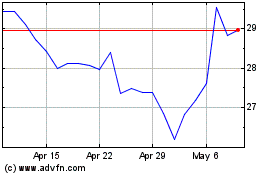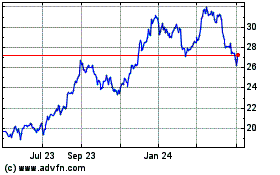Abu Dhabi Banks' Boards Approve Merger Plan
July 03 2016 - 9:20PM
Dow Jones News
DUBAI—Two of Abu Dhabi's top lenders on Sunday said their boards
have agreed on a merger plan that will create a Middle East banking
giant with $175 billion in assets and emerging market
ambitions.
The board of directors at National Bank of Abu Dhabi and First
Gulf Bank recommended merging the two lenders via a share-swap
transaction, which is expected to close in the first quarter of
2017, the banks said. The proposal was first announced last
month.
Combined, the new entity will have a market value of about $29
billion, larger than the likes of Standard Chartered and Deutsche
Bank.
Abu Dhabi is the capital of the seven-member United Arab
Emirates. Its economy largely depends on oil exports unlike
neighboring Dubai, which doesn't posses the same energy resources
and started diversifying years earlier. With its finances hit by
the two-year oil price slump, the emirate is consolidating its
assets to cut costs and create stronger entities to face economic
challenges. Last week, Abu Dhabi also engineered the proposed
combination of two large state investment funds.
With a bigger balance sheet and a network that extends to 19
countries, the new entity could give Abu Dhabi more financial
muscle and an international presence to support the emirate's
growth plans at home and overseas.
NBAD and FGB in the past few years have been trying to expand
their emerging markets presence as domestic growth has run out of
steam. FGB, for example, has a branch in Singapore and
representative offices in Hong Kong and Seoul. National Bank of Abu
Dhabi is active in the Far East as well, but also in Sã o Paulo,
Shanghai, Geneva and Washington, D.C.
"Expansion across fast growing emerging markets presents a vast
business opportunity for our customers and for us, as a larger,
stronger, combined bank," said Nasser Ahmed Alsowaidi, chairman of
NBAD. "We will have the capital, expertise and international
networks to be the preferred financial partner for anyone doing
business along the West-East corridor," Mr. Alsowaidi said.
Several regional banks have been reeling as a consequence of the
drop in energy prices. Governments from Abu Dhabi to Riyadh have
had to rein in spending as oil revenues dropped, dampening growth
in an already fragile economic environment. Government-owned banks
such as NBAD not only finance large infrastructure investments but
were also the prime recipients of government deposits when the
region was still awash with oil-dollars.
The merger may also spark more consolidation in the United Arab
Emirates banking sector where almost 50 local and international
banks compete. Merger activity of this size is rare in the Persian
Gulf, where the vast majority of banks are owned by local
governments or members of the ruling families, who are usually
reluctant sellers.
Under the terms of the deal, billed as a merger of equals, FGB
shareholders would receive 1.254 NBAD shares for each FGB share
they hold, implying a discount for FGB shareholders of 3.9% based
on the June 30 closing price. FGB's shares would be delisted after
the transaction is completed.
Once shareholders and regulators approve the merger, the Abu
Dhabi government and related entities would hold a 37% stake in the
new entity, which would retain the name of National Bank of Abu
Dhabi.
Abdulhamid Saeed, FGB's current managing director, has been
named to become the new bank's chief executive officer. He already
serves on several boards of regional investment entities, including
sovereign-wealth fund Mubadala. NBAD's current chief, former
Standard Chartered executive Alex Thursby, will continue to be at
the bank's helm until the merger is completed.
Credit Suisse and UBS were financial advisers to NBAD and FGB,
respectively, on the proposed merger.
Write to Nicolas Parasie at nicolas.parasie@wsj.com
(END) Dow Jones Newswires
July 03, 2016 21:05 ET (01:05 GMT)
Copyright (c) 2016 Dow Jones & Company, Inc.
UBS (NYSE:UBS)
Historical Stock Chart
From Mar 2024 to Apr 2024

UBS (NYSE:UBS)
Historical Stock Chart
From Apr 2023 to Apr 2024
